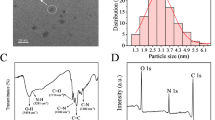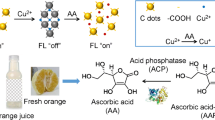Abstract
Herein, a visual and luminescent dual-mode (colorimetric and fluorometric) method for the detection of P-phenylenediamine (PPD) in hair dye was successfully established based on cerium-nitrogen co-doped carbon dots (Ce, N-CDs) that displayed remarkable luminescence and peroxidase activity. Ce, N-CDs catalyzed H2O2 to produce superoxide anion, which then oxidized the colorless 3,3,5,5-tetramethylbenzidine (TMB) into blue oxidized TMB (oxTMB), capable of quenching the fluorescence through fluorescence resonance energy transfer (FRET) between Ce, N-CDs and oxTMB. The reducing properties of PPD could reduce oxTMB back to TMB, leading to a decrease in the absorption intensity of oxTMB and a fluorescence recovery of Ce, N-CDs. As a result, the quantitative detection of PPD could be achieved by measuring the absorption values of oxTMB and the fluorescence signal of Ce, N-CDs. The detection limits for PPD were calculated as 0.36 µM and 0.10 µM for colorimetry and fluorimetry, respectively. Furthermore, smartphone application (ColorPicker) capable of measuring the RGB value of the color was utilized in the detection system, facilitating on-site quantitative detection. This approach effectively shortens the detection time and simplifies the operation, offering a powerful and convenient tool for real-time monitoring of PPD.








Similar content being viewed by others
Data Availability
The data that has been used is confidential.
References
Venkatesan G, Dancik Y, Sinha A, Kyaw HM, Srinivas R, Dawson TL, Bigliardi M, Bigliardi P, Pastorin G (2021) Development of novel alternative hair dyes to hazardous para-phenylenediamine. J Hazard Mater 402:123712
Kim K-H, Kabir E, Jahan SA (2016) The use of personal hair dye and its implications for human health. Environ Int 89–90:222–227
Antelmi A, Bruze M, Zimerson E, Engfeldt M, Young E, Persson L, Foti C, Sörensen Ö, Svedman C (2017) Evaluation of concordance between labelling and content of 52 hair dye products: overview of the market of oxidative hair dye. Eur J Dermatol 27:123–131
He J, Xu X, Sun H, Miao T, Li M, Zhou S, Zhou W (2023) Participation of Lattice Oxygen in Perovskite Oxide as a highly sensitive sensor for p-Phenylenediamine detection. Molecules 28:1122
Zhou J, Xu H, Wan G-H, Duan C-F, Cui H (2004) Enhancing and inhibiting effects of aromatic compounds on luminol–dimethylsulfoxide–OH – chemiluminescence and determination of intermediates in oxidative hair dyes by HPLC with chemiluminescence detection. Talanta 64:467–477
Guerra E, Lamas JP, Llompart M, Garcia-Jares C (2017) Determination of oxidative hair dyes using miniaturized extraction techniques and gas chromatography-tandem mass spectrometry. Microchem J 132:308–318
Bai Y-H, Li J-Y, Zhu Y-H, Xu J-J, Chen H-Y (2010) Selective detection of p-Phenylenediamine in hair dyes based on a special CE mechanism using MnO2 nanowires. Electroanalysis 22:1239–1247
Che Y-X, Hu J-P, Tao S-P, Lin Q, Yao H, Zhang Y-M, Wei T-B (2023) Constructing a novel turn-on fluorescent sensor based on phenazine macrocycle through halogen bond interaction for the naked-eye detection of phenylenediamine isomers. Sens Actuators B 393:134186
Gu M, Duan J, Mao Q, Zhang S, Lv J (2019) Direct chemiluminescent sensing of para-phenylenediamine over its isomers and analogues via luminol diazotization[J]. Sens Actuators B 287:173–179
Pot LM, Coenraads P-J, Blömeke B, Puppels GJ, Caspers PJ (2016) Real-time detection ofp-phenylenediamine penetration into human skin byin vivoRaman spectroscopy. Contact Dermat 74:152–158
Chen X, Feng M, Xie X, Zhang Y, Zhang J, Yang X (2022) Fe single atoms anchored on fluorine-doped ultrathin carbon nanosheets for sensitive colorimetric detection of p-phenylenediamine. Talanta 246:123487
Feng M, Zhang Q, Chen X, Deng D, Xie X, Yang X (2022) Controllable synthesis of boron-doped Zn–N–C single-atom nanozymes for the ultrasensitive colorimetric detection of p-phenylenediamine. Biosens Bioelectron 210:114294
Zhang S, Liu B, Hu D, Zhang S, Pei Y, Gong Z (2020) Sensitive and visual detection of p-phenylenediamine by using dialdehyde cellulose membrane as a solid matrix. Anal Chim Acta 1139:189–197
Cai Y, Zhu H, Zhou W, Qiu Z, Chen C, Qileng A, Li K, Liu Y (2021) Capsulation of AuNCs with AIE Effect into Metal–Organic Framework for the marriage of a fluorescence and Colorimetric Biosensor to detect Organophosphorus Pesticides. Anal Chem 93:7275–7282
Zhang J, Wang M, Liu J, Lv Y, Su X (2023) Construction of a dual-signal sensing platform based on DNA enhanced peroxidase-activity of iron cobalt oxide nanosheets for thrombin detection. Sens Actuators B 396:134526
Manioudakis J, Victoria F, Thompson CA, Brown L, Movsum M, Lucifero R, Naccache R (2019) Effects of nitrogen-doping on the photophysical properties of carbon dots. J Mater Chem 7:853–862
Yuan YH, Liu ZX, Li RS, Zou HY, Lin M, Liu H, Huang CZ (2016) Synthesis of nitrogen-doping carbon dots with different photoluminescence properties by controlling the surface states. Nanoscale 8:6770–6776
Wu Y, Ma G, Zhang A, Gu W, Wei J, Wang R (2022) Preparation of Carbon dots with Ultrahigh Fluorescence Quantum Yield based on PET Waste[J]. ACS Omega 7:38037–38044
Fan P, Liu C, Hu C, Li F, Lin X, Yang S, Xiao F (2022) Green and facile synthesis of iron-doped biomass carbon dots as a dual-signal colorimetric and fluorometric probe for the detection of ascorbic acid. New J Chem 46:2526–2533
Chu X, Ning G, Zhou Z, Liu Y, Xiao Q, Huang S (2020) Bright Mn-doped carbon dots for the determination of permanganate and L-ascorbic acid by a fluorescence on-off-on strategy. Microchim Acta 187:659
Zhang Z, Fan Z (2021) Application of cerium–nitrogen co-doped carbon quantum dots to the detection of tetracyclines residues and bioimaging. Microchim Acta 165:106139
Tao Y, Wan R, Wang J, Liu Q, Tian M, Wang L, Yang Y, Zou Y, Luo Y, Ke F, Zhou Q, Wang D, Gao D (2023) Carbonized human hair derived carbon dots for detection of clozapine. Spectrochim Acta Part A 298:122803
Tang Z, Dai Z, Gong M, Chen H, Zhou X, Wang Y, Jiang C, Yu W, Li L (2023) Efficient removal of uranium(VI) from aqueous solution by a novel phosphate-modified biochar supporting zero-valent iron composite. Environ Sci Pollut Res 30:40478–40489
Dai Z, Sun Y, Zhang H, Ding D, Li L (2020) Photocatalytic reduction of U(VI) in wastewater by mGO/g-C3N4 nanocomposite under visible LED light irradiation. Chemosphere 254:126671
Jana J, Lee HJ, Chung JS, Kim MH, Hur SH (2019) Blue emitting nitrogen-doped carbon dots as a fluorescent probe for Nitrite ion sensing and cell-imaging. Anal Chim Acta 1079:212–219
Peng B, Guo Y, Ma Y, Zhou M, Zhao Y, Wang J, Fang Y (2022) Smartphone-assisted multiple-mode assay of ascorbic acid using cobalt oxyhydroxide nanoflakes and carbon quantum dots. Microchem J 175:107185
Alshatteri AH, Ali GK, Omer KM (2023) Enhanced peroxidase-mimic Catalytic Activity via Cerium Doping of Strontium-based metal–Organic frameworks with Design of a smartphone-based sensor for On-Site salivary total antioxidant capacity detection in Lung Cancer patients. ACS Appl Mater Interfaces 15:21239–21251
Liang C, Lan Y, Sun Z, Zhou L, Li Y, Liang X, Qin X (2020) Synthesis of carbon quantum dots with iron and nitrogen from Passiflora edulis and their peroxidase-mimicking activity for colorimetric determination of uric acid. Microchim Acta 187:405
Han W, Miao C, Zhang X, Lin Y, Hao X, Huang Z, Weng S, Lin X, Guo X, Huang J (2021) A signal-off fluorescent strategy for deferasirox effective detection using carbon dots as probe and Cu2+ as medium. Anal Chim Acta 1179:338853
Liu M, Li S, Tang N, Wang Y, Yang X, Wang S (2020) Highly efficient capture of phosphate from water via cerium-doped metal-organic frameworks. J Clean Prod 265:121782
Sun X-H, Ma M, Tian R, Chai H-M, Wang J-W, Gao L-J (2023) One-Pot Hydrothermal Method Preparation of Cerium–Nitrogen-Codoped Carbon Quantum dots from Waste Longan Nucleus as a fluorescent sensor for sensing drug Rifampicin. ACS Omega 8:34859–34867
Du H, He L, Zhang M, Manyande A, Chen H (2023) Carbon quantum dots derived from fish scales as fluorescence sensors for detection of malachite green. J Food Meas Charact 17:3368–3376
Zhang R, Liu L, Li W, Luo X, Wu F (2023) Luminescent carbon dots with excellent peroxidase mimicking property for fluorometric and colorimetric detection of glucose. Colloids Surf B 222:113125
Yuan X, Zhao H, Yuan Y, Chen M, Zhao L, Xiong Z (2022) CuCo2S4 nanozyme-based stimulus-responsive hydrogel kit for rapid point-of-care testing of uric acid. Microchim Acta 189:283
Peng L-J, Zhou H-Y, Zhang C-Y, Yang F-Q (2022) Study on the peroxidase-like activity of cobalt phosphate and its application in colorimetric detection of hydrogen peroxide. Colloids Surf 647:129031
Xu Y, Li P, Hu X, Chen H, Tang Y, Zhu Y, Zhu X, Zhang Y, Liu M, Yao S (2021) Polyoxometalate nanostructures decorated with CuO nanoparticles for sensing ascorbic acid and Fe2+ ions. ACS Appl Nano Mater 4:8302–8313
Zhu Y, Deng X, Chen J, Hu Z, Wu F (2023) Coffee grounds-derived carbon quantum dots as peroxidase mimetics for colorimetric and fluorometric detection of ascorbic acid. Food Chem 429:136957
Lian T, Chen J, Tang X, Qiu P, Hu Y (2024) Bifunctional Fe-MOF@Fe3O4NPs for colorimetric and ratiometric fluorescence detection of uric acid in human urine. Microchem J 196:109538
Zhou X, Zhang J, Huang D, Yi Y, Wu K, Zhu G (2023) Nitrogen-doped Ti3C2 MXene quantum dots as an effective FRET ratio fluorometric probe for sensitive detection of Cu2+ and D-PA. Spectrochim Acta Part A 293:122484
Li Z, Zhou Z, Wang J, Sun Q, Zhang J, Tao T, Fu Y (2023) Ratiometric fluorescence detection of doxorubicin by R-CQDs based on the inner filter effect and fluorescence resonance energy transfer. New J Chem 47:3541–3548
Funding
This work was supported by the National Natural Science Foundation of China (No. 82073604 and 82304195).
Author information
Authors and Affiliations
Contributions
Q. L. Conceptualization, Methodology, Investigation, Writing - review & editing. Y.Y. Methodology. W. W. Writing - review & editing. B. L. Investigation. W. T. Data curation, Investigation. X.Z. Investigation, Validation.J. L. Conceptualization, Supervision, Writing e review & editing, Funding acquisition. S.Y. Supervision, Funding acquisition, Writing e review & editing.
Corresponding authors
Ethics declarations
Ethical Approval
Not applicable.
Competing Interests
The authors declare no competing interests.
Additional information
Publisher’s Note
Springer Nature remains neutral with regard to jurisdictional claims in published maps and institutional affiliations.
Electronic Supplementary Material
Below is the link to the electronic supplementary material.
Rights and permissions
Springer Nature or its licensor (e.g. a society or other partner) holds exclusive rights to this article under a publishing agreement with the author(s) or other rightsholder(s); author self-archiving of the accepted manuscript version of this article is solely governed by the terms of such publishing agreement and applicable law.
About this article
Cite this article
Li, Q., Yin, Y., Wang, W. et al. A Dual-Signal Sensing for the Visual and Luminescent Detection of p-Phenylenediamine Based on Cerium-Nitrogen-Co-Doped Carbon Dots. J Fluoresc (2024). https://doi.org/10.1007/s10895-024-03696-8
Received:
Accepted:
Published:
DOI: https://doi.org/10.1007/s10895-024-03696-8




